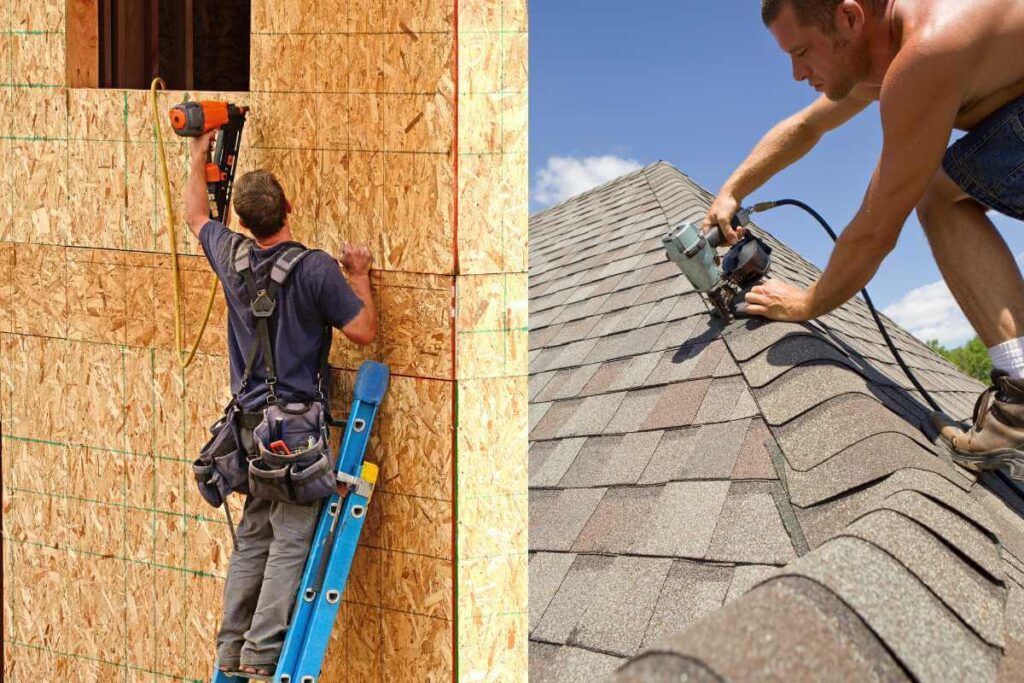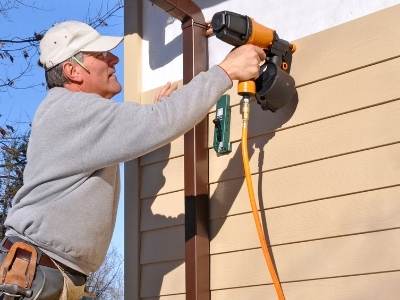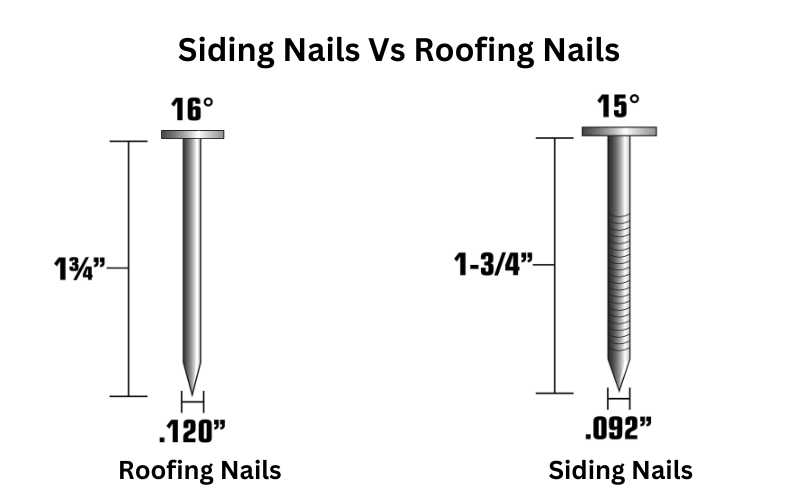It’s a common question among homeowners: Should I use a siding nailer or a roofing nailer?
To answer this, let’s take a closer look at each tool. Roofing nails, with their wide heads and pyramidal points, are designed to be driven into wood or composite decking easily. On the other hand, siding nails have narrower heads and rounded points, allowing them to slide under the siding without snagging on joints or other parts of the surface.
Roofing nails are specifically used to attach shingles, while siding nails secure vinyl siding in place. Although some people think these tools can be used interchangeably, there are significant differences between them.
Let’s dive deeper into the distinctions between siding nailers and roofing nailers.

Siding Nailer Vs Roofing Nailer: An Overview
Professional woodworkers know exactly what tools they’ll need to complete their projects and gather them properly. However, as DIY homeowners, we are constantly looking for multipurpose equipment that may be utilized for a number of tasks.
A framing nailer, for example, can be used for various tasks such as framing, decking, sheathing, fencing, hanging picture frames on the wall, assembling furniture, and more.
However, this isn’t always the case, and we regularly have to deal with specialized tasks such as installing hardwood floors and fixing roof shingles or vinyl sidings, which necessitate the use of specialized equipment like a roofing nailer or siding nailer. Because regular frame nailers aren’t designed to do those jobs.
The fact that the roofing nailer and siding nailer have such a close resemblance often perplexes us. They not only have the same shape, but they also operate on the same principles.
Roofing Nailer:
They’re not like other types of nail guns you’ve usually seen. They are designed to drive nails into asphalt and fiberglass shingles, watertight tarpaper, or insulating boards of various kinds. Roofing nailers are designed precisely for what they are designated for, whether you are installing a new roof or re-roofing.

The roofing nailers are often equipped with coil-type magazines to reduce the number of reloads. Depending on the power source, they can be pneumatic or cordless. Pneumatic roofing nailers are the most common and widely used among them.
Because the roofing season is so brief, roofing nailers are designed to be sturdy enough to be used year after year. Roofing nails, on the other hand, are meant to be easily taken out as the shingles need to be replaced at any moment (due to damage by a natural calamity) or after a set period of time.
Siding Nailer:
If you look at the siding nailer for the first time, you cannot distinguish it from a roofing nailer. However, siding nailers are particularly built to attach siding to exterior walls instead of driving nails or fixing roof shingles.

Siding nailers are frequently used to secure vinyl siding to wood, which is retrofitted in nature. This means they are prone to crack in extreme weather conditions like cold or intense sun. If you don’t leave enough space between the nails while nailing, it may break. Siding nailers are designed with these considerations in mind.
Like roofing nailers, the magazine of siding nail guns is also coil-type, and they run on either compressed air or battery power. They are usually lightweight and allow the user to work for a long time without fatigue. And they can generally drive comparatively thin heads and longer nails at a faster rate.
The most significant difference between a siding nailer and a roofing nailer, as we’ve seen, is the nails they’re built to shoot. Let’s take a closer look at each of them to learn more about them and determine which one is best for a homeowner.
Roofing Vs Siding Nailer: A Close Comparison
You will find a wide variety of nail guns all using either compressed air or battery or gunpowder to fire nails to fasten materials. Each of them has a specific job. But when you compare roofing nailer with siding nailer, you find that both accept coil collation, which leaves you in confusion.
I hope after reading the below comparison, all the confusion will be eradicated and you can choose the right tool.
Intent and Design:
Siding Nailer:
Despite their identical architecture and operating principles, they are designed to perform different jobs. Siding nailers, which resemble coil frame nailers, are used to secure exterior sidings such as wood, vinyl, aluminum, or fiber cement. They’re usually strong but light, so they can drive long nails into the siding to keep it firmly in place.
Roofing Nailer:
On the other hand, roofing nailers are also coil-type nailers that are used to install asphalt composite shingles (consisting of fiberglass with a mineral or asphalt coating), metal, wood, or synthetic (rubber) shingles. They are usually less expensive and have less power than siding nailers.
Note: No clear winner. Both are designed to perform some specific tasks.
Nail Used:
The nails that roofing and siding nailers are designed to fire are the main differentiating factor between them.
Roofing Nailer:
As roofing shingles are only meant to last 20 years or less, you’ll need to re-roof your home after that time. Roofing shingles may also be damaged by poor weather or natural disasters, which shorten the re-roofing interval. Roofing nails are made with this in mind. They usually have a large head and a smooth shank that are easy to draw out when needed.
Typically, roofing nails are shorter than siding nails, with a maximum length of 1-3/4 inches. Though they do not need to be long enough because the roofing materials are thin, they must have sufficient punching power and strength to puncture the composite or fiber cement shingles easily.
Siding Nailer:
Sidings, on the other hand, are designed to last a long time and do not require as much maintenance as roofing materials. As a result, siding nails are made to be sturdy and non-pull-out. On top of that, to provide better holding capacity, they are usually built with a ring shank. They’re also little heads since they don’t need to pull out frequently.
Though most siding materials (wood, plywood, or vinyl) are not thick enough, they are longer. The standard length of the siding is 2 to 12-1/2 feet, the width is usually 8–12 inches, the thickness varies from.035 to 1 inch, and the weight ranges from 4.5 to 12 pounds, depending on the materials.
So, they must be properly installed in the frame in order to hang for a long time and respond to external conditions.
Note:
As a result, siding nails must be long enough to penetrate the structure sufficiently. That’s why they are longer than roofing nails, ranging from 1-1/4 to 2-1/2 inches in length.
Another aspect we notice is that the roofing nails usually come with a galvanizing coating to protect against rusting, which is also true for siding nails. Hot-dip galvanized siding nails will give you more strength and durability than average.

Weight Comparison:
The weight of a siding or roofing nailer is entirely dependent on the manufacturer’s design and models. Different models have different weights and occasionally overlap with each other.
Because siding nailers are used vertically, they are usually built lighter than roofing nailers. Users will experience hand fatigue if they use a heavy siding nailer. Siding nailers weigh between 4.5 and 5 pounds, while roofing nailers weigh from 5.5 to 6 pounds.
Price Comparison:
Like weight, the price of siding and roofing nailers varies depending on the model and who makes them. Generally speaking, siding nailers are more expensive than roofing nailers. The cost of a mid-level siding nailer ranges from $150 to $350, and the cost of a mid-level roofing nailer is between $100 and $250.
When we compared the prices of siding nails and roofing nails, we discovered that they differed by the same proportion. Siding nails are more expensive than roofing nails since they are a little longer.
Depth Of Drive Adjustment:
Because roofing nails are typically pounded such that they are constantly flush with the shingles, a depth of drive adjustment system in a roofing nailer is not essential.
On the other hand, Siding nails are longer and require constant adjustment of the driving depth dependent on the materials and climate conditions. As a result, a siding nailer must have a variable driving depth.
Magazine Style:
You may be aware that magazine loading mechanisms of nail guns come in two varieties: coil and straight. We see that all the roofing nailers on the market have coil style magazines, whereas siding nailers have both sorts. Coil style magazines are preferable as they can provide greater leverage by reducing reloading frequency for both nailers.
Cross-Application:
Though it is recommended to use a siding nailer for siding and a roofing nailer for roofing shingles, they are not interchangeable. However, you can use a roofing nailer for installing sidings such as Hardie’s siding in some cases.
“You can use a roofing nailer (1-3/4” galvanized nails) to install siding if you “blind nail” them, so you won’t see the nail head at all.”
Said Frank Snyder
Specifications:
If you look at the specifications of both nailers, you’ll notice that there are more similarities than differences. Core specifications, such as dimension, power supply, operation pressure or battery voltage, magazine loading, built materials, and so on, are fully dependent on the nailer models.
A Quick Contrast of Siding and Roofing Nailers
| ROOFING NAILER | SIDING NAILER | |
|---|---|---|
| POWER | Pneumatic and cordless | Pneumatic and cordless |
| MAGAZINE STYLE | Coil | Coil and Straight |
| NAILS | Built for ousting | Aim to be eternal |
| Nail Head Size | Wide (around 0.3 to 0.375 inches) | Narrow (around 0.281 to 0.312 inches) |
| Shank Type And Diameter | Berbed, Deformed, or Smooth Shank (around 0.128 to 0.131 inches or 10 to 12 gauges) | Ring Shank (around 0.08 to 0.092 inches) |
| Nail Lengths | 1 to 1-3/4 inch | 2 to 3 inches long, based on siding thickness |
| Nail Materials Type | Aluminum, Steel, Galvanized | Steel, Copper, Hot-dip galvanized |
| Compatible For | Attach roofing shingles made of fiberglass (mineral or asphalt topping), wood, metal, synthetic (rubber), waterproof tarpaper, etc. | Attach sidings made of vinyl, wood, plywood, aluminum, fiber cement, cedar (tongue and groove), etc. |
| DEPTH OF DRIVE | Almost absent in every model | Present in many models |
| WORKING PRESSURE | Need less air pressure as not drive deep enough | Need more air pressure as deeply drive nails |
| DURABILITY | Durable enough to last season after season | Durable to fire long nails precisely |
| PORTABILITY | Comparatively Heavy | Lighter than roofing nailers |
| AFFORDABILITY | Comparatively Cheaper | A bit higher priced |
| COMFORT | Provide great comfort to do roofing or re-roofing | Provide great comfort to attach a wide range of siding and exterior trim |
Siding Vs Roofing Nailer: Which Is The Must-Have Tool For A Homeowner?
If you read our previous discussion on roofing nailers vs siding nailers, you’ll notice that they have a lot of differences. As a result, we can conclude that the roofing nailer is superior for roofing projects and the siding nailer is preferable for siding projects, and neither can replace the other.
In a nutshell, if a DIY homeowner plans to install their own roofing or re-roof, a roofing nailer is a must-have. A siding nailer, on the other hand, is a must-have if they plan to install sidings.
They can consider other options, such as employing general-purpose nail guns, but this will not be a good selection, and they may wind up with a huge mess.
FAQs For Siding Nailer Vs Roofing Nailer
What is the main difference between a siding nailer and a roofing nailer?
The main difference between a siding nailer and a roofing nailer lies in their intended applications. A siding nailer is designed specifically for installing siding materials, such as vinyl, wood, or fiber cement siding.
On the other hand, a roofing nailer is specifically used for installing roofing materials, like asphalt shingles, felt paper, or other roofing components.
Can I use a siding nailer for roofing or vice versa?
While it may be tempting to use one type of nailer for both siding and roofing tasks, it is not recommended. Siding nailers are not suitable for roofing materials due to their typically lower driving force, which may not securely fasten roofing materials.
Similarly, using a roofing nailer for siding may result in overdriven nails or damage to the siding material due to the higher driving force of roofing nailers. It is best to use each nailer for its designated purpose.
Are there any differences in nail type and length used in siding and roofing nailers?
Yes, there are differences in the nails used for each type of nailer. Siding nailers typically use coil or strip nails with a smaller diameter and a longer length, suited for securely fastening siding materials.
In contrast, roofing nailers use coil nails with a larger diameter and shorter length, optimized for the installation of roofing materials.
Using the wrong type of nail can lead to improper fastening and may void any warranties.
Can I adjust the depth of drive on both siding and roofing nailers?
Yes, both siding and roofing nailers come with adjustable depth-of-drive settings. These settings allow you to control the depth to which the nail is driven into the material. Adjusting the depth is crucial to ensuring the nails are flush with the surface, providing a neat and professional finish while preventing damage to the materials.
Which safety precautions should I take when using either type of nailer?
Safety is paramount when using any power tool. When using a siding or roofing nailer, always wear appropriate personal protective equipment (PPE), such as safety glasses, hearing protection, and work gloves. Keep your hands away from the nailer’s firing area and ensure it is disconnected from the air supply when not in use.
Additionally, familiarize yourself with the nailer’s user manual to understand its features and operating instructions thoroughly. Regularly inspect the nailer for any signs of damage or wear and perform maintenance as recommended by the manufacturer.
Related Reviews:
- Hammer Vs Framing Nailer Vs Palm Nailer: An Intensive Comparison
- Brad Nailer Vs Finish Nailer: Reveal The Truth Behind It
- Finish Nailer Vs Framing Nailer: Which Is Good For What?
- Nail Gun Not Shooting Nails – What Would You’ve To Do Next?
- How To Install Hardie Siding Without A Nail Gun?
Tools Mirror is reader-supported. When you shop through retailer links on our site, we may earn an affiliate commission at no cost to you.
Recent Posts
Woodworking in 2025 is all about efficiency, precision, and smart technology. Whether you're a beginner or a seasoned craftsman, having the right tools can make all the difference. Here are the top 7...
Ever tried drilling into a piece of wood only to end up with a splintered mess or a wobbly hole? Yeah, it's more common than you think. Wood might seem like an easy material to work with, but...

